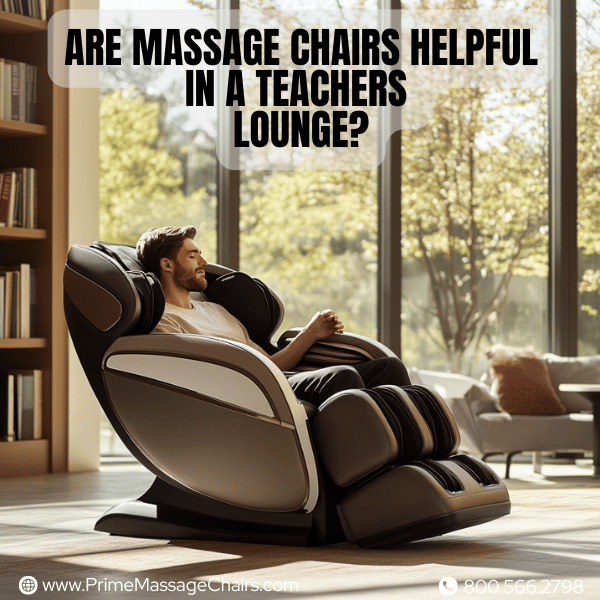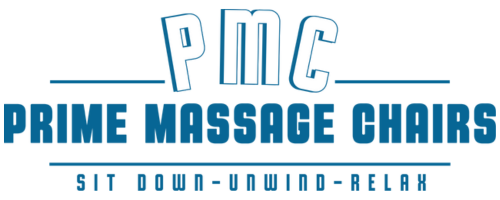
Are Massage Chairs Helpful in a Teachers Lounge?
Are massage chairs helpful in a teachers lounge? Teachers often work hard and may feel stressed. Putting massage chairs in the teachers lounge could help reduce their stress.
This blog will explain how massage chairs may support teachers' well-being.
Keep reading to learn more!
Benefits of Massage Chairs in a Teachers Lounge
Installing massage chairs in a teachers' lounge may help reduce stress and muscle pain, which could improve focus and job satisfaction.
These chairs might also enhance blood circulation and promote full-body relaxation, making them a potentially beneficial addition to schools.
Reduces Stress and Anxiety
Teachers may encounter a high level of tension daily. A massage chair in the teachers' room could help with this tension.
It might allow them to feel more at ease and less anxious. By using the chairs, teachers may decompress and better manage work-related stress.

The presence of these chairs could enhance the lounge ambiance, making it a more welcoming space.
This improved atmosphere might promote better teaching performance. Teachers may manage difficulties more efficiently and demonstrate increased patience with their students.
These chairs might also help with muscle aches and back discomfort, though individual results may vary and effectiveness could depend on factors like chair design and duration of use, which could contribute to overall well-being.
Relieves Muscle Tension and Pain
Massage chairs may help reduce stress and anxiety for teachers. They could also ease muscle tension and pain.
These potential benefits are important for teachers who spend much of their day standing or sitting, which may lead to back and shoulder discomfort.
By applying pressure to the body, massage chairs might improve blood circulation. This improvement could help with lower back issues and reduce leg swelling from prolonged standing.
The chairs may encourage muscle relaxation, which might ease pain and support overall wellness among educators.
This support could be helpful in managing the physical demands of teaching, which may contribute positively to teacher health.
Improves Focus and Mental Clarity
Teachers may use massage chairs to help reduce stress. They could focus better and teach more effectively.
A dedicated relaxation area with massage chairs might help teachers unwind. This may benefit the whole school by supporting learning and potentially reducing absenteeism due to stress.
Schools might notice improved teacher performance and lower stress levels when teachers have access to relaxation techniques such as massage chairs.
Boosts Emotional Well-Being and Morale
Massage chairs may help boost teachers' happiness and spirit.
They could show teachers their hard work is noticed, potentially lifting moods and providing support in the lounge.

This may create a more positive atmosphere in schools, where teachers who feel supported might engage more with students, leading to improved learning environments.
Better circulation and physical relaxation from massage chairs could play a role in supporting this positive change, based on general user experiences.
Enhances Circulation and Physical Relaxation
Massage chairs in the teacher lounge may help with circulation, based on general observations and user experiences.
This might help teachers feel less stiff from standing or sitting all day. It could also lower burnout and absenteeism by supporting physical well-being.
Using massage chairs may let teachers take a break, relax their muscles, and clear their minds. Better circulation might reduce aches and pains.
Even a short time in a massage chair could improve how teachers feel during the day.
Ideal Features in Massage Chairs for Teachers
Teachers may benefit from massage chairs for commercial use. Massage chairs with the following features could help them relax and reduce stress during their busy day:
Zero-Gravity Reclining
Zero-gravity massage chairs may distribute a teacher's weight more evenly. This could improve blood flow and reduce lower back pressure.
Schools that offer these chairs might demonstrate care for teacher wellness. They may help reduce stress and lower absenteeism caused by illness or fatigue.
These chairs might also include heat therapy and massage features, which could enhance relaxation during breaks.
Providing a calm space with zero-gravity chairs may allow educators to rest properly during short breaks.
Heated Massage Functionality
Heated massage chairs may offer deep relaxation.
They could warm muscles, easing stress and reducing stiffness or discomfort. This might be helpful for teachers who spend long hours standing or sitting.
Some models may offer customizable massage experiences. Not all chairs have the same features, so schools should evaluate which ones may be most appropriate for their staff’s needs.
Others could target specific areas like the spine or thighs with multi-directional massage movements.
These features might help lift spirits and ease tension, supporting a sense of calm after busy school days.
Adjustable Intensity Levels
Massage chairs may let teachers adjust the strength of their massage. Various options might allow for comfort and relief, whether addressing back discomfort or simply relaxing.
These chairs could also show that schools care about teacher health and well-being. Teachers might choose the massage spot and speed for added comfort during breaks.
Chairs that target different body parts may help ease stress after a full day of teaching and grading.
Compact and Space-Saving Designs
Compact massage chairs may fit well in small teachers' lounges. They could provide effective massages without needing much space.
Some models may include user-friendly panels, making them good for shared areas. Others might offer features like inversion therapy and heat, which could help create a relaxing space for teachers.
These chairs may support improved moods and help reduce burnout in limited lounge areas.
Creating a Relaxing Teacher Lounge Space
Transforming the teacher's lounge with massage chairs and plants may create a calming effect.
Adding soft lights and aroma oils could enhance relaxation, although the effects of aromatherapy may vary and are often based on personal preference or anecdotal experiences, potentially creating a spot for staff to unwind.
Incorporating Massage Chairs Into the Design
Adding massage chairs to the teacher's lounge may help with relaxation and stress management.
Placing them in areas where teachers gather could improve the break room atmosphere. Offering massage chairs might show support for teachers' mental health and well-being.

Choosing compact massage chairs may save space, allowing room for tables and other furniture. Incorporating soft lighting and plants could help create a calm environment.
These elements may make the lounge more inviting, promoting connection among staff while supporting their well-being during breaks.
Adding Calming Elements: Plants and Soft Lighting
- Plants and soft lighting in the teacher lounge may help create a peaceful space.
- Greenery could help calm teachers and potentially improve air quality, although its air-purifying effect may depend on various factors and is still debated in scientific studies. Soft lights may add a cozy, relaxing vibe, different from typical school rooms.
- This environment might allow teachers to unwind during their day. These changes could benefit teachers at work.
- They may help lower stress and support mental wellness. With plants, the lounge may feel like a mental health sanctuary, promoting wellness for school staff.
- These elements might contribute to enhancing the overall well-being of anyone in a school environment.
Including Wellness Additions: Aromatherapy and Quiet Zones
- Some schools now use scents like lavender and peppermint to help teachers feel calm.
- These smells may reduce stress related to teaching, though their effectiveness is subjective and not universally proven and feeling overwhelmed during the school year.
- Quiet areas in schools might allow teachers to meditate or reflect quietly, away from noise and work discussions.
- This could show the school's support for staff mental health. It may give them space to breathe and prepare for their day ahead.
- Such efforts might improve how teachers feel at work, possibly leading to greater satisfaction and better connection with colleagues.
Long-Term Benefits of Massage Chairs for Teachers
Massage chairs may help teachers reduce stress and avoid burnout, though they should not be considered a replacement for professional medical or psychological support, potentially improving their focus on teaching.
This support could be helpful for maintaining both physical and mental well-being in the educational environment.
Combating Teacher Burnout
Teachers may face a lot of stress from their work and related challenges. This stress could lead to burnout, making teachers feel tired and less effective in class.
Burnout might also lead to more sick days, which could impact schools and students.

Installing massage chairs in the teachers' lounge may help lower burnout by giving teachers a way to relax and relieve stress or discomfort.
Teachers who feel more relaxed might perform better and may be absent less often.
Teachers who feel supported could help foster a more positive environment for both students and the school community.
Promoting Wellness and Mental Health
Massage chairs in teachers' lounges may support well-being and morale.
They could signal care for both physical and mental health, helping create a space for relaxation, connection, and collaboration.
School leaders and wellness teams may play a role in improving these areas. A relaxed teacher might perform better, potentially becoming more creative in their work.
As a result, installing massage chairs could be a helpful strategy to support teachers' mental wellness.
FAQs
1. How Can Massage Chairs Be Beneficial in a Teacher's Lounge?
Massage chairs may help promote relaxation and reduce stress for teachers and staff.
After a long, demanding day of work, spending time on a massage chair could help soothe their muscles.
2. Can Having Massage Chairs Show Appreciation Towards Teachers?
Yes, providing a massage chair may be a thoughtful way to show teacher appreciation. It might suggest that the school leadership values their hard work and well-being.
3. Does It Promote Connection and Collaboration Among Faculty Members?
Indeed, having shared resources like a massage chair in the lounge may encourage interaction among faculty members, which could support connection and collaboration.
4. Is It Feasible to Have Licensed Therapists Instead of Massage Chairs?
While having a licensed massage therapist might be ideal, it may not always be practical due to cost or availability.
Massage chairs could provide some similar benefits at any time without requiring scheduling or extra staff.
5. Will Adding These Amenities Affect the Ambiance of Our Teachers' Lounge?
Adding elements like massage chairs could improve your space's ambiance if planned thoughtfully.
Consider factors such as wall colors and existing furniture to ensure a harmonious design.
Conclusion
Are Massage Chairs Helpful in a Teachers Lounge? Massage chairs in teacher's lounges may offer notable benefits, though outcomes may vary depending on the type of chair and individual user experiences.
They could help reduce stress and promote relaxation for teachers. These chairs often have heated massage features and various intensity levels to meet different needs.
Adding plants and soft lights may also improve the space for relaxation. This setup could help reduce teacher burnout and support mental health by offering a space to relax and recharge.
Disclaimer:
We do not provide medical advice. The content of this article, including text, graphics, and other material, is for informational purposes only. It is not intended to be a substitute for professional medical advice, diagnosis, or treatment. Always seek the advice of your physician or other qualified health provider with any questions you may have regarding a health condition. Never disregard professional medical advice or delay in seeking it because of something you have read in this article or on our website.
